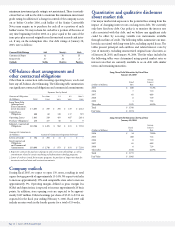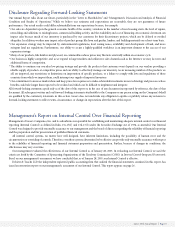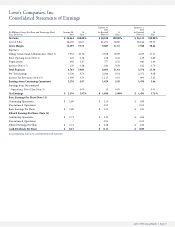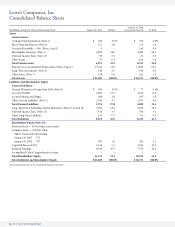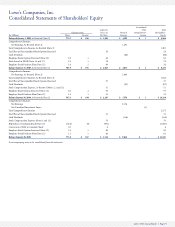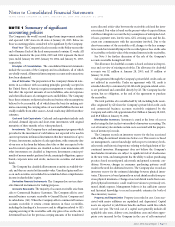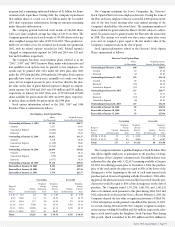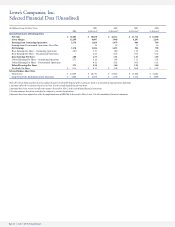Lowe's 2004 Annual Report Download - page 34
Download and view the complete annual report
Please find page 34 of the 2004 Lowe's annual report below. You can navigate through the pages in the report by either clicking on the pages listed below, or by using the keyword search tool below to find specific information within the annual report.
Page 32 Lowe’s 2004 Annual Report
assets. Upon disposal, the cost of properties and related accumulated
depreciation are removed from the accounts, with gains and losses
reflected in the consolidated statements of earnings.
Depreciation is provided over the estimated useful lives of the depre-
ciable assets. Assets are depreciated using the straight-line method.
Leasehold improvements are depreciated over the shorter of their esti-
mated useful lives or the term of the related lease, which may include
one or more option renewal periods where failure to exercise such
options would result in an economic penalty in such amount that
renewal appears, at the inception of the lease, to be reasonably assured.
During the term of a lease, if a substantial additional investment is made
in a leased location, the Company also reevaluates its definition of lease
term to determine whether the investment would constitute an eco-
nomic penalty in such amount that renewal appears, at the time of the
reevaluation, to be reasonably assured.
Impairment/Store Closing Losses related to impairment of long-
lived assets are recognized when circumstances indicate the carrying val-
ues of the assets may not be recoverable. The Company periodically
reviews the carrying value of long-lived assets for potential impairment.
When management commits to close or relocate a store location, or
when there are indicators that the carrying value of a long-lived asset
may not be recoverable, the Company evaluates the carrying value of the
asset in relation to its expected undiscounted future cash flows. If the
carrying value of the assets is greater than the expected undiscounted
future cash flows and the fair value of the assets is less than the carrying
value, a provision is made for the impairment of the assets based on the
excess of carrying value over fair value.
When a leased location is closed, a provision is made for the present
value of future lease obligations, including property taxes, utilities, and
common area maintenance, net of anticipated sublease income.
Provisions for impairment and store closing costs are included in selling,
general and administrative (SG&A) expenses.
Leases Assets under capital leases are amortized in accordance with
the Company’s normal depreciation policy for owned assets or if short-
er, over the non-cancelable lease term and any option renewal period
where failure to exercise such option would result in an economic penal-
ty in such amount that renewal appears, at the inception of the lease, to
be reasonably assured. During the term of a lease, if a substantial addi-
tional investment is made in a leased location, the Company also reeval-
uates its definition of lease term to determine whether the investment
would constitute an economic penalty in such amount that renewal
appears, at the time of the reevaluation, to be reasonably assured. The
charge to earnings is included in depreciation expense in the consoli-
dated financial statements.
For lease agreements that provide for escalating rent payments or
free-rent occupancy periods, the Company recognizes rent expense on a
straight-line basis over the non-cancelable lease term and option renew-
al periods where failure to exercise such options would result in an eco-
nomic penalty in such amount that renewal appears, at the inception of
the lease, to be reasonably assured. The lease term commences on the
date when all conditions precedent to the Company’s obligation to pay
rent are satisfied.
Self-Insurance The Company is self-insured for certain losses relat-
ing to worker’s compensation, automobile, property, general and
product liability claims. The Company has stop-loss coverage to limit
the exposure arising from these claims. Self-insurance claims filed and
claims incurred but not reported are accrued based upon manage-
ment’s estimates of the discounted ultimate cost for uninsured claims
incurred using actuarial assumptions followed in the insurance indus-
try and historical experience. Although management believes it has the
ability to adequately record estimated losses related to claims, it is
possible that actual results could differ from recorded self-insurance
liabilities. The Company’s self-insurance liability was $432 million and
$327 million at January 28, 2005, and January 30, 2004, respectively,
and is included in other current liabilities in the accompanying con-
solidated balance sheets.
Income Taxes Income taxes are provided for temporary differences
between the tax and financial accounting bases of assets and liabilities
using the asset and liability method. The tax effects of such differences
are reflected in the balance sheet at the enacted tax rates expected to be
in effect when the differences reverse.
Store Opening Costs Costs of opening new or relocated retail stores,
which include payroll and supply costs incurred prior to store opening
and grand opening advertising costs, are charged to operations as
incurred.
Revenue Recognition The Company recognizes revenues when sales
transactions occur and customers take possession of the merchandise. A
provision for anticipated merchandise returns is provided in the period
that the related sales are recorded. Revenues from product installation
services are recognized when the installation is completed. Deferred rev-
enues associated with amounts received for which customers have not yet
taken possession of merchandise or for which installation has not yet
been completed were $265 million and $200 million at January 28, 2005,
and January 30, 2004, respectively. These amounts are included in other
current liabilities in the accompanying consolidated balance sheets.
Revenues from gift cards are deferred and recognized when the cards
are redeemed. The liability associated with unredeemed gift cards was
$264 million and $201 million at January 28, 2005, and January 30,
2004, respectively, and these amounts are included in other current lia-
bilities in the accompanying consolidated balance sheets.
Extended Warranties Beginning in 2003, Lowe’s began selling sepa-
rately priced extended warranty contracts under a new Lowe’s-branded
program for which the Company is the primary obligor. The Company
recognizes revenue from extended warranty sales on a straight-line basis
over the respective contract term. Incremental direct acquisition costs
associated with the sale of extended warranties are also deferred and rec-
ognized as expense on a straight-line basis over the respective contract
term. All other costs, such as costs of services performed under the con-
tract, general and administrative expenses and advertising expenses are
expensed as incurred. Deferred revenues related to the Company’s
extended warranty sales were $86 million and $8 million at January 28,
2005 and January 30, 2004, respectively.
Advertising Costs associated with advertising are charged to oper-
ations as incurred. Gross advertising expenses were $740 million, $682
million and $608 million in 2004, 2003 and 2002, respectively.
Cooperative advertising vendor funds of $2 million, $673 million and
$583 million in 2004, 2003 and 2002, respectively, were recorded as a
reduction of these expenses with the net amount included in SG&A
expense. The reduction of the amount of cooperative advertising vendor
funds recorded as a reduction of advertising expenses in 2004 is a result
of the implementation of Emerging Issues Task Force Issue No. 02-16
(EITF 02-16), “Accounting by a Customer (Including a Reseller) for




